
Title
Discourse no Shinrigaku (The psychology of discourse: Finding new possibilities in qualitative research)
Size
252 pages, A5 format
Language
Japanese
Released
April 10, 2015
ISBN
9784623073306
Published by
Minerva Shobo
Book Info
See Book Availability at Library
Japanese Page
This book is probably Japan’s first book on “discourse analysis.” Many readers are likely to be unfamiliar with the word “discourse.” I want you to read Chapters 1–3 for further details about discourse, but put simply, “discourse” means “communication” or “conversation,” and discourse analysis is research that deals with the society and culture behind linguistic expressions.
To help you better understand discourse analysis, let me give you an example. If you were to analyze this passage that you are now reading, in a quantitative analysis, you would probably count the number of letters and words to conduct a statistical test, and in a qualitative analysis, you would probably read the content of the passage. However, discourse analysis focuses on how this passage is “portrayed.” For instance, it examines sentence construction, such as where the outline is discussed in the preceding paragraph, and then presents examples. It would also examine aspects such as the style of writing that speaks to readers as if to say, “it is probably X,” and the sense of discord between the picture on the cover of this book (attached above) and the text. Furthermore, discourse analysis examines the influence of the context of the discourse on society. Through such analysis, one can probably pursue different perspectives than those prevalent in psychological research.
This book comprises 12 chapters. The first three chapters, written by three co-editors, are introductory in nature. These introductory chapters discuss topics such as the relationship between discourse analysis and other qualitative analyses, the history of its development, and attitudes toward the treatment of experience.
The next nine chapters demonstrate the practice of discourse analysis. The topics addressed have a common theme of psychology or, more broadly, they shed light on people’s way of life. Aside from this, they differ from each other on the basis of the authors’ interests and areas of expertise, which are wide-ranging and include color blindness, mothers of children with mental disabilities, survivors of suicide attempts and the atomic bomb explosions. The analyzed data are varied and include interviews, previous literature, and observations. The methods of analysis range from those that broadly analyze the flow of the whole text to those that analytically examine slight nods and hesitations in a conversation. The authors are both researchers and practitioners of psychology. Discourse analysis has its roots in sociology and linguistics. After its emergence, a large volume of criticism and disputes concerning attitudes and approaches in discourse analysis arose among researchers. Based on the history of its development and the diversity of the topics discussed in this book, you may feel that discourse analysis is applicable to a wide range of fields and has significant prospects.
You can deepen your understanding of discourse analysis by reading the book in order from Chapter 1 to Chapter 12, or you can start reading from a research topic of your interest. I want you to appreciate the appeal of discourse analysis at your own pace. I would be happy if this book allows you to reflect on your life and the society you live in.
(Written by NOCHI Masahiro, Professor, Graduate School of Education / 2018)



 Find a book
Find a book




